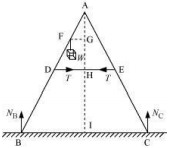The given situation can be shown as:
NB = Force exerted on the ladder by the floor point B
NC = Force exerted on the ladder by the floor point C
T = Tension in the rope
BA = CA = 1.6 m
DE = 0. 5 m
BF = 1.2 m
Mass of the weight, m = 40 kg
Draw a perpendicular from A on the floor BC. This intersects DE at mid-point H.
ΔABI and ΔAIC are similar
BI = IC
Hence, I is the mid-point of BC.
DE || BC
BC = 2 × DE = 1 m AF =
BA – BF = 0.4 m … (i)
D is the mid-point of AB.
Hence, we can write:
...(ii)
Using equations (i) and (ii), we get:
FE = 0.4 m
Hence, F is the mid-point of AD.
FG||DH and F is the mid-point of AD. Hence, G will also be the mid-point of AH.
ΔAFG and ΔADH are similar
In ΔADH:
For translational equilibrium of the ladder, the upward force should be equal to the
downward force.
= mg = 392 … (iii)
For rotational equilibrium of the ladder, the net moment about A is:
Adding equations (iii) and (iv), we get:
For the rotational equilibrium of the side AB, consider the moment about A.


